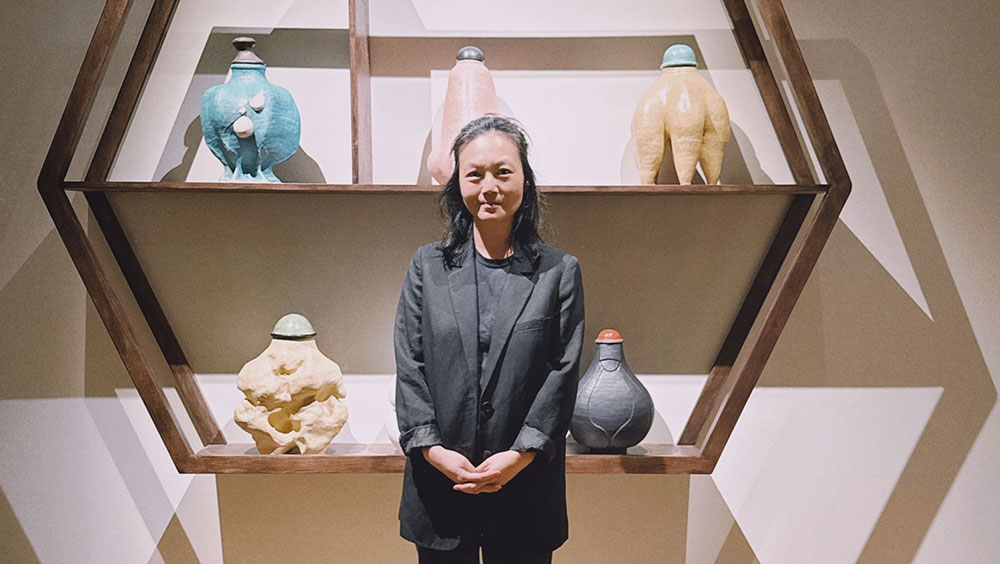
Renee So. Photo courtesy of the artist.
by SABINE CASPARIE
It is the second time in three months that I have come to interview an artist at Compton Verney in Warwickshire and, walking over the elegant bridge and between the beautiful redwood trees, I am thinking that any artist with the opportunity to exhibit here is extremely lucky. An Art Fund Museum of the Year 2025 finalist, the stately home is set in 120 acres (486,000 sq metres) of beautiful gardens, with a wide variety of trees and dotted with contemporary sculptures. Renee So was delighted when Compton Verney approached her to exhibit a few years ago, but it wasn’t just for the beautiful surroundings. “It felt really good, and personally relevant to me, because I have an interest in artefacts,” So tells me, walking up the stairs to the exhibition, due to open that evening. “And also a bit daunting.”
‘I had to address my own identity, which I think I have been avoiding so far’
So wants to show me some of the museum collection first, and especially the Chinese galleries. Owned by several generations of the Verney family, the stately home had become almost derelict by 1993, when Sir Peter Moores took it over under his Peter Moores Foundation and brought his eclectic art collection, among which were some Chinese bronzes. The collection grew and now comprises bronze ritual vessels and other artefacts from the early Shang Dynasty (c1500 to 1050BC) to the Tang Dynasty (AD618-906). So has always been interested in historic objects from different cultures, elements of which she transforms into her own unique sculptures and textiles. “This exhibition is building on things I was already thinking about, but it changed the direction to China,” So explains. “I had to address my own identity, which I think I have been avoiding so far. Being born in Hong Kong, I am Chinese and I am not Chinese. Hong Kong was a British colony, and that brought good and bad elements. On the one hand we had a democracy, on the other hand colonisation.”
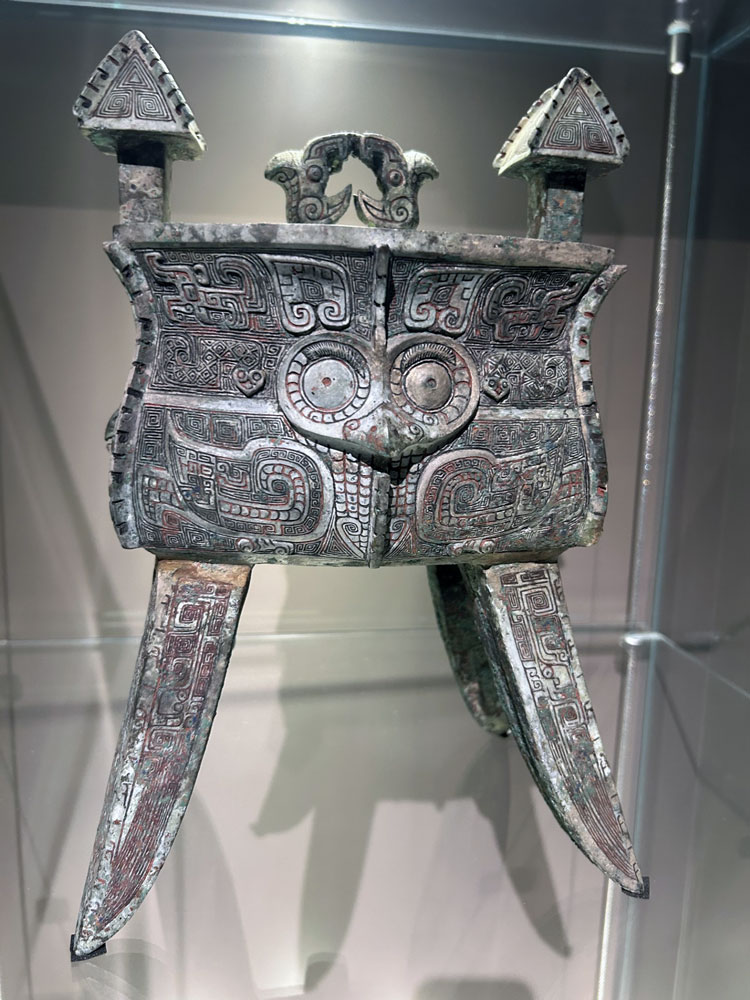
Wine vessel and cover, fangjia, with owl motif. Late Shang Dynasty (about 1550-1050 BC). Bronze, 30.7 cm high. Part of the Chinese bronze collection at Compton Verney. Photo: Sabine Casparie.
We stop in front of two intricately decorated bronze vessels with a luminous green patina, and So points to one in the form of an owl’s face, and the little worm on either side of it. “This is the Taotie, a mythological symbol found on many ritual bronze vessels, related to silk weaving.” I can see how this appeals to So, whose practice focuses on how historic symbols can be abstracted into new ideas and forms. “My interest in China and ancient Chinese culture is layered: the objects themselves, the mythology, the civilisation. And then on another level, there is the trade between China and Europe, and the exploitation.”
.jpg)
Renee So: Commodities – Sculpture and Ceramic, installation view, Compton Verney. Copyright Compton Verney and Jamie Woodley.
These themes become clear in the first gallery of So’s exhibition, comprising a series of oversized snuff and perfume bottles, made of ceramic. The objects are artfully displayed in four geometric, suspended “shelf units” designed by the artist and made of stained plywood. I ask So if she has designed anything like this before. “No! My sculptures are usually on plinths,” she replies, smiling, “but this space is more like a house than a white cube. Snuff bottles are domestic objects, and they would have been collected by wealthy ladies and aristocrats living in stately houses like this one. Snuff bottles are small, so the Europeans would display them together on shelves or cabinets, as collectibles. But in China, where the snuff bottles originated, they were used by the palace for imperial use only.”
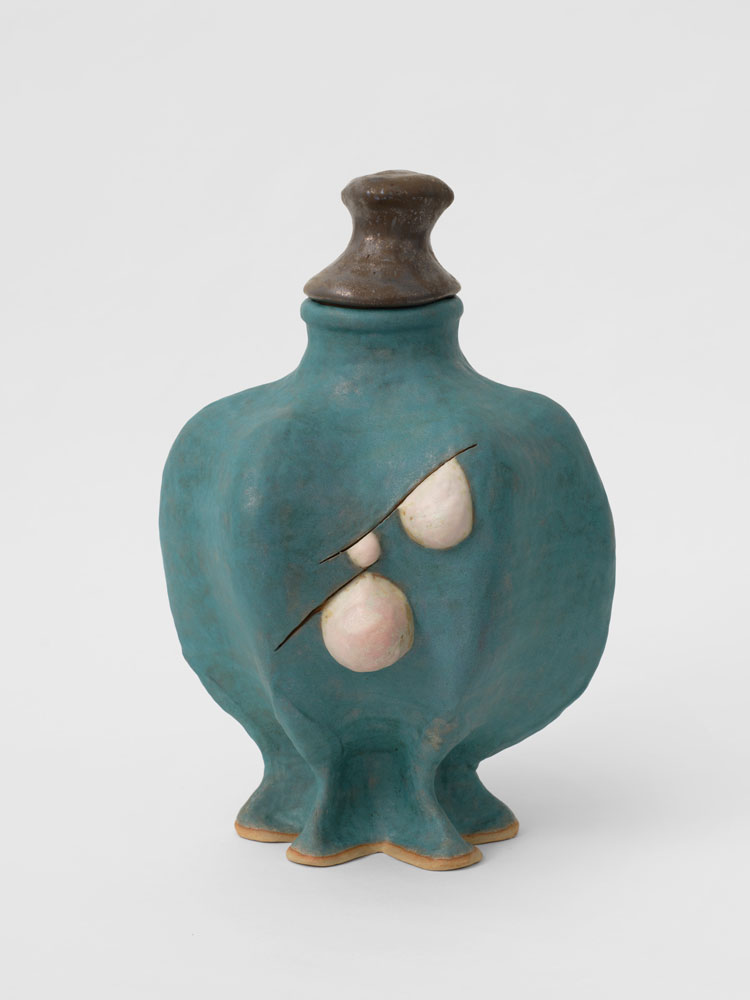
Renee So, Poppy Head Snuff Bottle, 2024. Glazed stoneware, 42 x 27 x 21 cm. Courtesy the artist and Kate MacGarry. Photo: Ben Westoby.
So began making this series in 2019, when she became fascinated by the influence of the snuff bottle on 20th-century perfume design. Both have their origins in the act of sniffing, taking something in through the nose, and one of So’s bottles is shaped like a nose. Another is shaped like a poppy, the raw material for opium. “I was thinking about fragrance and the reasons why people sniff the bottle or wear the fragrance is to transform their mental state. Early perfume bottle designers often referenced snuff bottles for their Asian themes: in the oriental design – each one is like a miniature sculpture – but also in the titles. I studied the archives and I noticed that perfume titles like to play on vice and deadly sins. There is ‘Poison’ and there are drug references like ‘Opium’ and ‘Addict’.” So points out other names on the ceramic sculptures – “Wars”, “Invasion”, “Colony” – and it is hard to believe that these were (and some still are) sold and consumed for pleasure. “For men, it is about dominance and violence, so the titles have a military, masculine sentiment; for the women, there are titles that suggest succumbing to something, being weak, or crazy or wild. The perfume-maker is trying to capture the essence of some emotion or some feeling in a fragrance, but it’s kind of uncomfortable and intangible.”
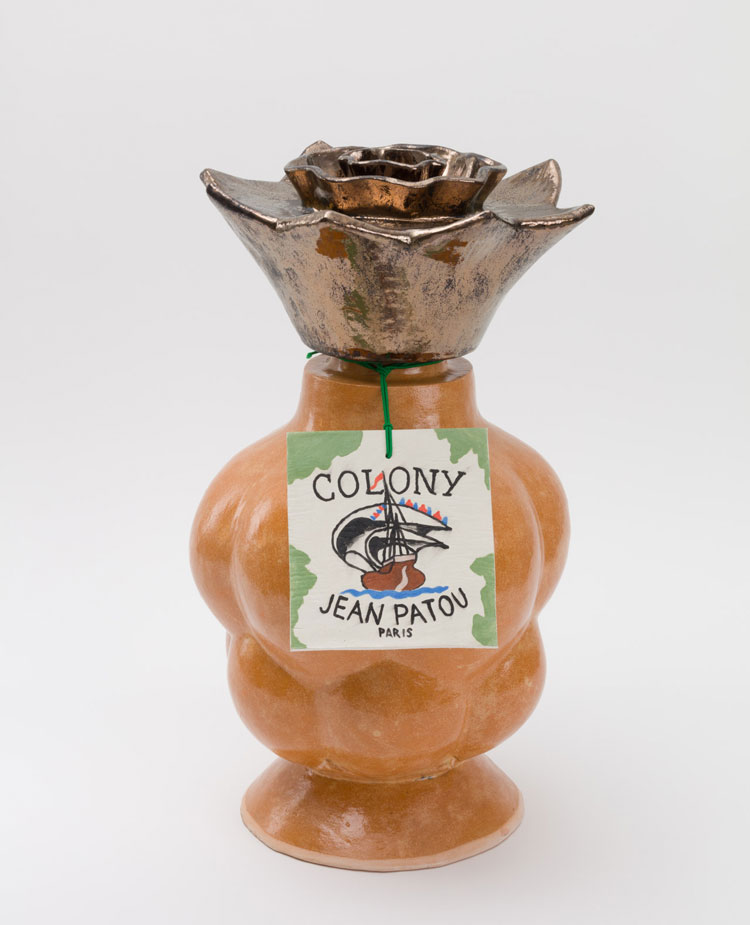
Renee So, Colony by Jean Patou, Perfume Bottle, 2024. Glazed earthenware, 53 x 22 x 25 cm. Courtesy the artist and Kate MacGarry. Photo: Angus Mill.
I tell So that I read somewhere that her sculptures are usually the size of her kiln. “Yes! They have to be, otherwise it becomes too costly. If I am over by 5cm it is going to cost me £200! Like this one,” she says, pointing to a snuff bottle in the shape of a white Pekingese dog. “When the British invaded and burned down the palace, they stole one of the dogs and they took it back to England and gave it to Queen Victoria, and she named it ‘Looty’. That’s how the Pekingese breed was introduced to the rest of the world. And it’s why everyone wanted one – because they were exotic.” So mentions “oriental” and “exotic” several times, and there is, of course, a fine line between desiring something because it is beautiful and appropriating a cultural object with the hints of power that act entails. I ask if she considers her work to be political. She hesitates. “I like showing the different influences that cultures have on one another, sometimes to make a point, but I am also very interested in how people respond to certain ideas creatively. The English kept snuff in boxes, which dried it out, but the Chinese snuff bottles were better because they had a small opening, which kept it moist. I am interested in the commodification of objects. It can happen to other things, too, like football players – some people just play it as a game but is has also become really professionalised. Of course there is another layer behind this: of colonisation and the trade resulting from that.”
.jpg)
Renee So: Commodities – Sculpture and Ceramic, installation view, Compton Verney. Copyright Compton Verney and Jamie Woodley.
The football theme is further explored in the second gallery, where a “magic mirror”, suspended from a red steel construction based on ancient depictions of a football goal, projects an image on the opposite wall, of two women playing football. “Magic mirrors were invented in China under the Han dynasty (206BC – AD220), but I encountered them via a different route,” So explains. “The Peter Moores Foundation, which took over Compton Verney, made most of its money from football and so I went to the Fifa Museum’s website and looked through their collection. They had an ancient Chinese bronze mirror, and it showed women playing football. I loved it! Football was invented in China and women were playing it from the beginning.” On the wall is a ceramic mural of two women with traditional Chinese hairdos, kicking a bright red football between them.
.jpg)
Renee So: Commodities – Sculpture and Ceramic, installation view, Compton Verney. Copyright Compton Verney and Jamie Woodley.
There are similarities with So’s earlier work, unglazed ceramic sculptures of women: the women appear at once classical, mythological and contemporary. “What is it about the female figure from past civilisations that appeals to you?” I ask. “I like how they had different beauty standards,” says So. “The earliest representations of women were the Venus figures, and they were very … large!” And there was something quite minimal in their form. I do like outline, and flat colour. There is that direct communication.”
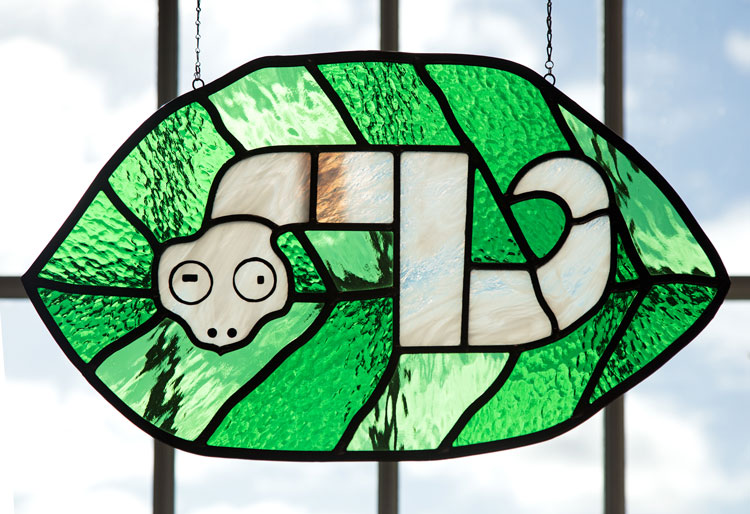
Renee So: Commodities – Sculpture and Ceramic, installation view, Compton Verney. Copyright Compton Verney and Jamie Woodley.
The theme of womanhood is prominent in the next room, too, although we are introduced to it via a worm. The worm appears in a pet-sized ceramic sculpture with a bronze glaze (on a plinth this time) and lying on a leaf in a stained-glass sculpture suspended in front of the window, reflecting the green grass outside. “The image of the Taotie looks abstract, but it is derived from a worm and a moth,” So explains. “Silk production was invented by a Chinese woman, the Empress. The story goes that the Empress sat under a mulberry tree, when a silk cocoon fell into her cup of tea. The heat released a thread from the cocoon, and that’s how she discovered silk. She started keeping the worms and then she invented a loom to weave.” I wander off to admire a sculpture of a turtle, the same patinated green as some of the objects in Compton Verney’s Chinese collection. “The three main inventions during the Shang Dynasty were silk production, bronze casting and writing,” So says. “I have tried to capture that by making ceramics with bronze glazes. I like to explore the differences between cultures, but also what is universal: pottery and later bronze casting developed simultaneously in different countries and cultures; people started playing games with a ball everywhere around the world at a similar time.”
Indeed, walking around the exhibition with So feels familiar and new, like being immersed in another time and place while at the same time recognising visual signs. Was she always interested in storytelling? “I used to read mostly non-fiction, but recently I have become interested in fiction again,” she says. In fact, So included a table with books in an “educational room”; there are memoirs by Asian writers and books on the Opium wars, but also a treatise called Football & Fortunes (which charts the history of Littlewoods Football Pools, the business associated with Sir John Moores, Peter Moores’ father) and a book by Michael Pollan on mind-expanding plants (it investigates the effects of opium and caffeine on the mind, relating to both the “Opium” and “Tea” fragrances in the first gallery – and also to the Opium wars, which were started because of the British desire for tea from China). “The history I am interested in I didn’t learn in school. I remember when I first came to London in 2005 and I visited the V&A museum – I had never seen anything like it! The vessels had so much personality. They were used as practical objects, for storing wine and food, and now they are decorative objects sitting on a shelf in a museum,” says So.
.jpg)
Renee So: Commodities – Sculpture and Ceramic, installation view, Compton Verney. Copyright Compton Verney and Jamie Woodley.
We have come to the end of the exhibition and stop in front of a second ceramic mural: a framed mosaic showing a woman in So’s trademark simple lines and matt, flat colour. The woman has a sleek haircut, an almost classical bust, and the blue pants and black boots that also appear in So’s earlier sculptures and textiles of Bellarmine men (So encountered Bellarmine vessels in the V&A. These German stoneware jugs, which were made between the 16th and 18th centuries for drinking and storing ale or wine and featuring the face of a wild-looking bearded man, were exported widely across Europe, including to England). The woman crouches down, reaching out to a green tray with white silkworms, the gesture kind and caring. “It was a bit intimidating, being asked to exhibit here and feeling that you are representing your group,” So says. “I don’t want to be a representative. And at the same time my story is not unique: I lived in different countries, I am an immigrant, it was tough sometimes. My work carries references from east and west. She points to the crouching woman. “But this work is not talking about some abstract woman in the past; it is a self-portrait. There is something of the inner child here that we all have. I also keep worms, although not for silk but for compost,” So laughs.
As So told me, her love of design comes from the joy of a well-realised idea. I walk away thinking that So’s art is about so much more than that. It traverses the world and connects the dots: from China to London, from snuff to scent, from mythology to merry drinking, from worm to woman.
• Renee So: Commodities – Sculpture and Ceramics is at Compton Verney, Warwickshire, until 8 March 2026.